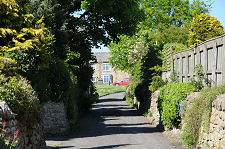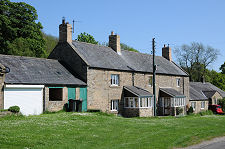 The Village Green and the War Memorial in Wall |
The A6079 heads north from the A69 near Hexham before crossing the line of Hadrian's Wall near Chesters and continuing on through Chollerton towards its meeting with the A68. There are places along the route that command attention, but it has to be admitted that Wall, which you pass a mile south of the junction with the B6318, isn't really one of them.
All you see of the village are the backs of some very pleasant honey coloured stone houses on the east side of the road, and The Hadrian Hotel, built in the 1800s, on the west side of the road. Plus some cottages, and a more modern structure housing a garage selling cars at the top end of the village. This is all to the good, because the fact that the main road only grazes one edge of Wall is one of the things that make this such a lovely little village.
At the heart of Wall is an extensive village green largely surrounded by inward facing houses and cottages, with an "island" comprising more houses and the church in the centre of the green. The north-west corner of the green focuses on the village's war memorial, while nearer its centre is the village "pant" or pump, which once supplied clean water.
The church is dedicated to St George, and was built in 1895, while on the south side of the green is the Methodist Chapel, built in 1868. On the north-east side of the village is a sports field and public conveniences, in an area which appears to double as an informal camping ground: albeit one that seems to get very boggy after bad weather. Wall's name and, we suspect, a fair proportion of its building material, came from its proximity to the line of Hadrian's Wall, which passes less than half a mile to the north.
While Wall is a lovely place, what really makes it rather special is the reason why it was built: or perhaps that should be the manner in which it was built. You don't have to spend much time in Northumberland before coming across bastle houses, in various states of repair. The area on both sides of the Anglo Scottish border was a very dangerous place to live for a number of centuries. One response on the Northumberland side of the border, especially between about 1550 and 1650, was to build defensible "bastle houses".
Bastle houses came in a variety of forms and sizes, but most were rectangular and had accommodation for animals on the ground floor, and for people on the first floor. They would not withstand an army, but were intended to keep all the family's most valuable possessions, especially its animals, safe from the bands of border reivers who plagued the area. Some bastle houses were built singly, but in several places entire villages of them were built.
Wall is one of these bastle villages, and as you look around the green, a good analogy is to think of the wagon train in the cowboy film pulled round into a circle to fend off an attack by indians. The idea at Wall was to build an enclosure of bastle houses around the village green. In times of trouble the livestock could be herded from the surrounding pasture land onto the village green at night, with protection afforded by the ring of bastle houses. When attack was known to be imminent, the animals would be moved into the lower levels of the houses, and the residents would seek to defend the village from within their houses. In one bastle village a curtain wall linked the houses together, though this was not the case at Wall.
At least nine of the houses in Wall can be identified as originally having been built as bastle houses, though they have all been altered significantly since. Most prominent among them is Greenhead House, in the north-west corner of the green, while another two stand on the north side of the green. Stable Cottage stands in the centre of the green, while Fellfoot can be found on its eastern side. Another one time bastle, Town Farm House, is on the south side of green, while two others are on the west side of the main road north of The Hadrian Hotel, suggesting that the green once extended further west than it does today.
 More of the Village Green, and the Pump |

|
|
|
Visitor InformationView Location on MapWhat3Words Location: ///boggles.wove.banks |
 Cottages |
 Old House, Stylish Extension |
 The Church |
 Much Altered Over the Centuries |
 Village Green, Looking East |
 South Side of the Village Green |





